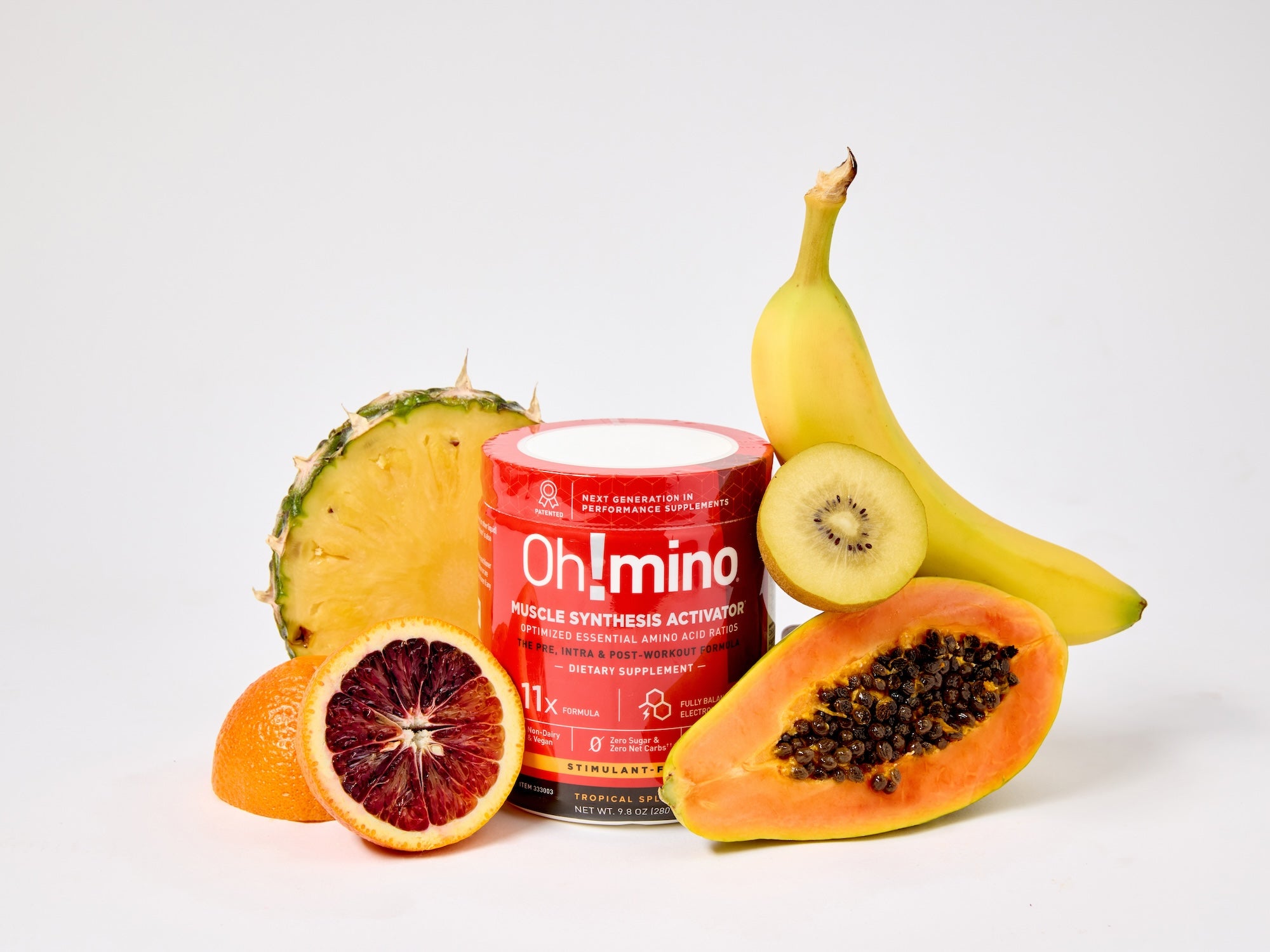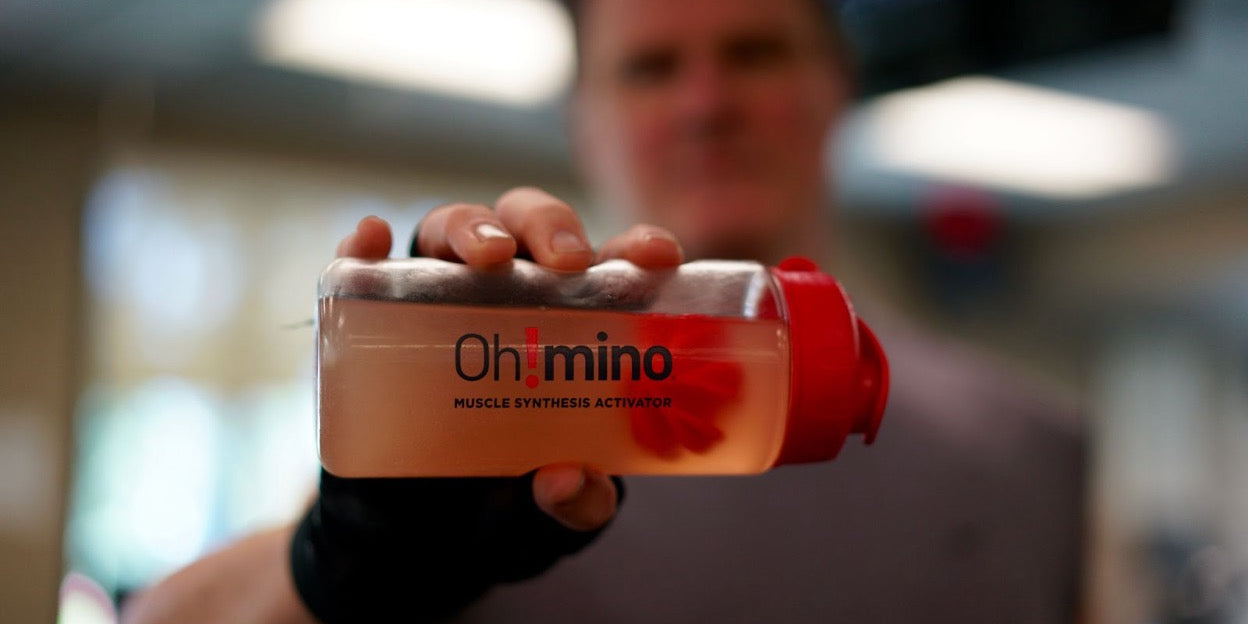Key Takeaways
-
EAAs contain all nine essential amino acids (including the three BCAAs) your body needs, while BCAAs include only three essential amino acids (leucine, isoleucine, and valine).
-
EAAs provide more comprehensive support for muscle protein synthesis, making them generally superior for muscle building goals and superior recovery
-
BCAAs may help reduce exercise-induced muscle soreness and fatigue during workouts., but are limited
-
Your ideal supplement choice is EAAs!
-
Oh!mino® Muscle Synthesis Activator delivers all nine essential amino acids plus balanced electrolytes and adaptogens for superior hydration, recovery, and performance in one comprehensive formula.
EAAs vs. BCAAs: What's the Difference?
Before talking about which supplement reigns supreme, understand what each one actually is. The fundamental difference lies in their composition and how your body processes them. These differences directly impact how effective each supplement is for various fitness goals.
EAAs Explained
Essential amino acids (EAAs) refer to the nine amino acids that your body cannot produce on its own and must obtain through diet or supplementation. These include:
-
L-Leucine
-
L-Lysine
-
L-Threonine
-
L-Valine
-
L-Phenylalanine
-
L-Histidine
-
L-Isoleucine
-
L-Tryptophan
-
L-Methionine
These mighty nine are absolutely critical for numerous bodily functions, including protein synthesis, hormone production, and neurotransmitter formation. Without adequate amounts of all nine EAAs, your body can't efficiently build or repair muscle tissue.
BCAAs Defined
Branched-Chain Amino Acids (BCAAs) are a subset of EAAs, specifically leucine, isoleucine, and valine. These three have a unique branched molecular structure that affects how they're metabolized.
Your muscles can directly use BCAAs for energy during exercise, unlike other amino acids that must first be processed by the liver. This direct pathway is why BCAAs have gained popularity as an intra-workout supplement to combat fatigue and reduce muscle breakdown during intense training sessions.
However, the latest science suggests that the BCAAs work best when they are combined with the other six EAAs.
Key Structural Differences
The most obvious difference is that EAAs give you all nine essential amino acids, while BCAAs provide just three. This isn't simply a numbers game; it has real implications for muscle growth. Think of it like building a house: BCAAs might provide excellent foundation materials, but EAAs deliver the complete package of materials needed for construction. Without all essential amino acids present, your body faces limitations in how effectively it can synthesize new muscle protein, regardless of how many BCAAs you consume.
|
Oh!mino®: Elevate Your Performance. Accelerate Your Recovery. Science-Backed Superiority for Every Fitness Journey Power Your Goals with Proven Results:
The Oh!minoI® Advantage: ✓ Adaptogens boosts endurance and muscle fuel by 373% Choose Your Perfect Formula: Available in refreshing Tropical Slash or Berry Blast flavors, with stimulant-free or caffeinated options. Prefer capsules? We've got you covered with the same powerful formula. Take before, during, or after training—one solution for your entire workout. |
Muscle Growth Benefits EAAs vs BCAAs
EAAs for Synthesis
EAAs provide your body with all the raw materials necessary to construct new muscle tissue. Studies have shown that EAA supplementation stimulates muscle protein synthesis more effectively than BCAAs alone.
This makes perfect sense when you consider that muscle tissue requires all essential amino acids for complete development. The presence of amino acids like lysine and methionine (found in EAAs but not BCAAs) is crucial for optimal protein synthesis signaling pathways.
BCAAs for Triggers
BCAAs, particularly leucine, act as powerful triggers for the mTOR pathway, which is a key regulator of muscle protein synthesis. Leucine has been shown to activate mTOR signaling even in the absence of other amino acids, which explains why BCAA supplements can still provide some anabolic benefit.
However, this trigger effect is limited without the complete amino acid profile needed to actually build the muscle tissue.
Recovery Advantages
After an intense workout, your muscles are in a state of breakdown and require proper nutrition to repair and grow stronger. Amino acid supplements can accelerate this recovery process by providing readily available building blocks for muscle repair.
EAAs' Full Spectrum
EAAs provide comprehensive recovery support by supplying all the necessary amino acids for tissue repair. This complete profile ensures that your body can efficiently rebuild damaged muscle fibers without any nutrient limitations.
Additionally, EAAs support immune function during recovery periods, which is particularly important during high-volume or intense training phases when immune suppression can occur.
BCAAs' Specific Role
BCAA supplementation can significantly decrease delayed-onset muscle soreness (DOMS) and accelerate recovery between training sessions. This is partly because BCAAs reduce muscle protein breakdown during exercise and provide readily available energy for working muscles.
The anti-catabolic effects of BCAAs make them particularly useful during calorie-restricted diets or cutting phases when muscle preservation is a priority. When you're in a caloric deficit, your body may break down muscle tissue for energy; BCAAs can help mitigate this breakdown. But again, EAAs have the same effect, if not better.
Post-Workout Timing
The timing of amino acid supplementation can significantly impact recovery outcomes. Taking either EAAs or BCAAs immediately post-workout (within 30 minutes) provides the most benefit for recovery and protein synthesis.
Pre-workout or intra-workout consumption of BCAAs may be particularly effective for reducing exercise-induced muscle damage, while post-workout EAAs maximize the anabolic window for growth.
Performance Impact
Beyond recovery and muscle growth, amino acid supplements can directly influence your performance during workouts. The right supplement can help you push harder, last longer, and maintain better technique as fatigue sets in.
EAAs During Exercise
EAAs provide a more comprehensive energy source during prolonged exercise by supporting various metabolic pathways. The full spectrum of essential amino acids allows for better energy management, especially during extended training sessions.
Some studies suggest that EAA supplementation can improve exercise capacity and reduce central fatigue by optimizing neurotransmitter function, which helps maintain focus and performance during challenging workouts.
BCAAs and Fatigue
BCAAs have a well-documented effect on reducing central fatigue during exercise. This occurs primarily through the competition between BCAAs and tryptophan for entry into the brain. By blocking tryptophan uptake, BCAAs reduce the production of serotonin, a neurotransmitter associated with fatigue.
For high-intensity interval training (HIIT) or heavy resistance training, this fatigue-fighting effect can translate to more productive work sets and better performance.
Endurance Effects
For endurance athletes, the choice between EAAs and BCAAs might depend on the duration and intensity of their activity. Longer events (90+ minutes) typically benefit more from EAAs due to the comprehensive amino acid profile supporting extended performance and reduced muscle breakdown.
Meanwhile, the fatigue-reducing effects of BCAAs can be particularly beneficial during shorter, high-intensity endurance efforts where mental fatigue becomes a limiting factor.
Value Comparison
Cost Analysis
Generally speaking, BCAA supplements tend to be less expensive than EAA supplements. This price difference reflects the manufacturing complexity and the number of amino acids included in each formula. For many budget-conscious fitness enthusiasts, BCAAs might seem like the economical choice initially.
However, if your primary goal is muscle building, paying extra for EAAs might deliver better results per dollar spent since they provide complete protein synthesis support.
Supplement Quality
Not all amino acid supplements are created equal. High-quality supplements typically use fermented amino acids rather than those derived from animal hair or feathers (yes, really!). When in doubt, reach out to the manufacturer through their website FAQs, live chat, customer support line, or email for accurate info.
Premium EAA supplements like those from Oh!mino often contain vegan sources and are optimized ratios of amino acids based on human muscle tissue needs, which can significantly enhance their effectiveness compared to generic formulations.
Dosage Requirements
Effective dosages differ between EAAs and BCAAs, which impacts the overall value proposition. For BCAAs, research suggests that 5–10g per serving is optimal, while EAAs typically require 3–15g for maximum benefit. More important than dose load is the ratios of the nine EAAs.
This means you might go through your EAA supplement faster, effectively increasing the cost per day. However, considering you get all EAAs at a go, you are getting more value for money.
Implementation Strategy
Having the right supplement is only half the battle; knowing how to use it effectively is equally important. The right approach can significantly enhance the effectiveness of either EAAs or BCAAs within your training program.
Optimal Timing
For maximum benefit, timing your amino acid intake around your workout is crucial. EAAs work best when taken 15–30 minutes before training and immediately after to support muscle protein synthesis. Research shows that without free amino acids, exercise can only increase muscle synthesis to a limited capacity. So taking your EAAs before and after exercise ensures optimal results.
BCAAs on the other hand, can be particularly effective when consumed during longer training sessions (45+ minutes) to combat fatigue and reduce muscle breakdown. For fasted training, taking either supplement about 15 minutes before your workout can help preserve muscle tissue while providing energy support.
Stacking Options
Both EAAs and BCAAs can be effectively combined with other supplements to enhance their benefits. Common stacking options include pairing with creatine or improved strength and power output, electrolytes for better hydration during training, and cofactors to aid in absorption and performance,
Why Oh!mino's Complete Amino Acid Support Wins
Oh!mino® Muscle Synthesis Activator is the ultimate solution for serious athletes and fitness enthusiasts. Our formula combines all nine essential amino acids with five fully balanced electrolytes and powerful adaptogens like ginseng extract, delivering complete muscle synthesis support alongside superior hydration benefits.
Many of our customers observe noticeable improvements within 2–4 weeks of use.
Our patented balanced blend of L-Leucine, L-Lysine, L-Threonine, L-Valine, L-Phenylalanine, L-Histidine, L-Isoleucine, L-Tryptophan, and L-Methionine (as well as the only semi-essential amino acid, Glycine) works synergistically to maximize muscle protein synthesis, while the integrated electrolytes direct water to where it's needed most during intense training.
Simply mix 1–2 scoops with 8–12 oz of water and take it pre-workout for sustained energy, intra-workout for enhanced performance, or post-workout for accelerated recovery.
Mix 1–2 scoops with 8–12 oz of water and take it pre-workout for sustained energy, during your workout for enhanced performance, or post-workout to support faster recovery.
Rather than choosing between incomplete solutions, Oh!mino® provides the complete package your body deserves. Our stimulant-free formula gives you everything needed to crush your fitness goals in one comprehensive, scientifically formulated product.
When your success depends on having the right fuel at the right time, why settle for anything less than complete amino acid support?
Try Oh!mino® Muscle Synthesis Activator today.
Frequently Asked Questions (FAQ)
Can I take both EAAs and BCAAs together?
Yes, you can take both supplements, though it's generally unnecessary since EAAs already contain all the BCAAs.
If you choose to use both, a strategic approach would be using BCAAs during workouts for their fatigue-fighting benefits and EAAs post-workout for maximum recovery support.
This method allows you to leverage the unique benefits of each supplement without excessive overlap.
Do EAAs break a fast during intermittent fasting?
Technically yes, amino acids can trigger an insulin response, which breaks a strict fast. However, the insulin response is minimal compared to carbohydrates or complete proteins.
Many intermittent fasting practitioners consider EAAs and BCAAs "fasting-friendly" supplements that can be used during fasted training to preserve muscle mass without significantly compromising the metabolic benefits of fasting.
How quickly do amino acids work after consumption?
Amino acid supplements are rapidly absorbed, typically reaching peak blood levels within 30–60 minutes after consumption. This fast absorption rate makes them ideal for pre-workout and intra-workout nutrition when you need quick delivery to working muscles.
The performance effects (like fatigue reduction) can be felt within this timeframe, while the recovery and muscle protein synthesis benefits continue for several hours after intake.
Are there any side effects from taking amino acid supplements?
Most people tolerate amino acid supplements well when taken at recommended dosages. Occasional side effects may include gastrointestinal discomfort, especially when consumed in large amounts or on an empty stomach.
Some users report headaches or fatigue with excessive BCAA intake, possibly due to neurotransmitter imbalances.
What makes Oh!mino® Muscle Synthesis Activator different from other amino acid supplements?
Oh!mino® Muscle Synthesis Activator stands out as a complete solution that combines all nine essential amino acids with five fully balanced electrolytes and powerful adaptogens in one formula.
Unlike single-focus supplements, our patented formula provides comprehensive support to gain strength, build muscles and recover faster! The vegan formula can be used pre-workout, intra-workout, and post-workout, to deliver enhanced muscle recovery and sustained performance.





